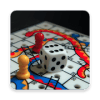手机游戏> SNAKE AND LADDER BOARD GAME : PLAY LUDO GAME FREE> 游戏攻略
SNAKE AND LADDER BOARD GAME : PLAY LUDO GAME FREE

SNAKE AND LADDER BOARD GAME : PLAY LUDO GAME FREE is an aged Indian board game regarded today as a worldwide classic. It is played between two or more players on a game board having numbered, gridded squares. A number of "ladders" and "snakes" are pictured on the board, each connecting two specific board squares. The object of the game is to navigate one's game piece, according to die rolls, from the start (bottom square) to the finish (top square), helped or hindered by ladders and snakes respectively. The game is a simple race contest based on sheer luck, and is popular with young children.[2] The historic version had root in morality lessons, where a player's progression up the board represented a life journey complicated by virtues (ladders) and vices (snakes). A commercial version with different morality lessons, Chutes and Ladders, The SNAKE AND LADDER BOARD GAME : PLAY LUDO GAME FREE was popular in ancient India by the name Moksha Patam. It was also associated with traditional Hindu philosophy contrasting karma and kama, or destiny and desire. It emphasized destiny, as opposed to games such as pachisi, which focused on life as a mixture of skill and luck. The SNAKE AND LADDER BOARD GAME : PLAY LUDO GAME FREE has also been interpreted and used as a tool for teaching the effects of good deeds versus bad. The board was covered with symbolic images, the top featuring gods, angels, and majestic beings, The number of ladders was less than the number of snakes as a reminder that a path of good is much more difficult to tread than a path of sins. Each player starts with a token on the starting square (usually the "1" grid square in the bottom left corner, or simply, off the board next to the "1" grid square) and takes turns to roll a single die to move the token by the number of squares indicated by the die roll. Tokens follow a fixed route marked on the gameboard which usually follows a survey track from the bottom to the top of the playing area, passing once through every square. If, on completion of a move, a player's token lands on the lower-numbered end of a "ladder", the player moves the token up to the ladder's higher-numbered square. If the player lands on the higher-numbered square of a "snake" (or chute), the token must be moved down to the snake's lower-numbered square. If a player rolls a 6, the player may, after moving, immediately take another turn; otherwise play passes to the next player in turn. The player who is first to bring their token to the last square of the track is the winner.



 粤公网安备44010602000283号
粤公网安备44010602000283号
